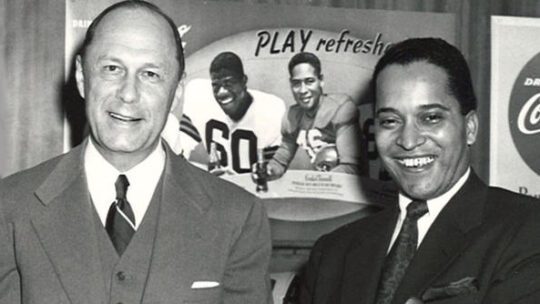
[Editor's Note: This piece was created by Jared Meade on behalf of the Museum of Public Relations in honor of Black History Month. The museum exhibits an extensive collection of Black history in the PR sector.]
The issue of underrepresentation of minorities in the media has been controversial matter for many years. However, thanks to the tireless efforts of many, harmful stereotypes and inadequate visibility are no longer as prevalent as they once were. Significant progress has been made in portraying a more accurate, equitable and just representation of various minority groups, such as African Americans, Asians, Hispanics, and Native Americans in the media.
Moss Kendrix, a pioneer in the field of public relations, played a significant role in transforming the portrayal of minorities, especially Black Americans, in the media over 75 years ago. His relentless efforts and innovative work revolutionized the depiction of the community, paving the way for improved representation in the media.
Kendrix's History
Born in Atlanta, Ga., in 1917, Kendrix attended Morehouse College, an all-male historically black college, where he was the editor of the school newspaper—The Maroon Tiger, co-founder of Phi Delta Delta Journalism Society (the first and only society of its kind for Black journalism students) and a member of the historic Alpha Phi Alpha Fraternity, Inc. He graduated in 1939 and was accepted into Howard University Law School but opted instead to gain work experience. That same year, he married Dorothy Marie Johnson, a student at Spellman College, the sister school to Morehouse, with whom he had two sons, Moss Kendrix, Jr. and Alan Kendrix.
In 1941, Kendrix's life took a sharp turn when he was drafted into the United States Army. He was assigned to work for the Treasury Department in the War Finance Office. He traveled across the country to promote war bonds with Black celebrities as part of his job. Two of his favorites were Duke Ellington and singer Billy Eckstine.
After serving in the military, Moss Kendrix established a public relations firm in Washington, D.C.—The Moss Kendrix Organization. He firmly believed that the public's perception mattered the most, which became his company's motto, "What the Public Thinks Counts!". The firm’s clientele included big names such as The Coca-Cola Company, Carnation, Ford Motor Company, the National Dental Association, the National Educational Association and the Republic of Liberia.
The Coca-Cola Years
Kendrix and his firm are best known for bridging the gap between The Coca-Cola Company and Black consumers. While Coca-Cola may be ubiquitous in 2024, there was a time when this wasn’t true, especially in the Black community. During the 1920s and 1930s, the community preferred fruit-flavored beverages produced by Nehi, a company that recognized the value of the minority market. At only 31 years old, Kendrix recognized the opportunity and presented Coca-Cola with the idea of targeting marketing efforts toward the Black community. As a result, he won the account, becoming the first Black PR representative to manage a major corporate account.
With the guidance of Kendrix, Coca-Cola started to feature the newly affluent, post-war Black consumers in a way similar to the "white suburban" markets. Before the Second World War, Black Americans were often depicted offensively and not given respect by advertisers. They were seen as a lesser class who produced or served but not those who bought or consumed goods. Kendrix helped Coca-Cola see the Black market as the consumers they were. The new advertisements showcased Black families, young Black couples on dates and famous Black athletes drinking Coke in various settings. In 1953, Coca-Cola published a full-page, four-color ad in EBONY featuring the popular Harlem Globetrotter Reese “Goose” Tatum. Kendrix also recruited Black college students such as Mary Alexander, the first Black woman to appear in a Coca-Cola advertisement.
Kendrix continued to work with Coca-Cola, shifting the consumer image of Black Americans in advertising until the early 1970s.
The Legacy of Kendrix
Kendrix’s push for more Black representation wasn’t limited to the media. In 1953, he launched the National Association of Market Developers (NAMD) at Tennessee State University to encourage and support minorities in the public relations field. NAMD was incorporated in D.C. in 1954 and is still in operation today.
While the name Moss Kendrix may not be widely known, especially outside the public relations field, his impact on advertising can be seen and heard in every image and voice of a Black American used on billboards and in print, display, mobile and broadcast advertising.
We may still have a way to go, but without the work of Kendrix and others like him, the portrayal of Blacks, Asians, Hispanics, Native Americans and other minorities wouldn’t be where it is today. Kendrix opened the eyes of corporate America to the buying power of Black Americans, but he also opened the world's eyes to the importance of accurately portraying minorities in breaking down prejudices and stereotypes.
Kendrix passed away from a heart ailment on Jan 4, 1989, at the age of 71, in his home in Washington. Despite his passing, he left a legacy that will touch the lives of generations to come.
Jared Meade, MPS, APR, MPRCA is Founder and Principal, Rayne Strategy Group. He is writing on behalf of the Museum of Public Relations.
